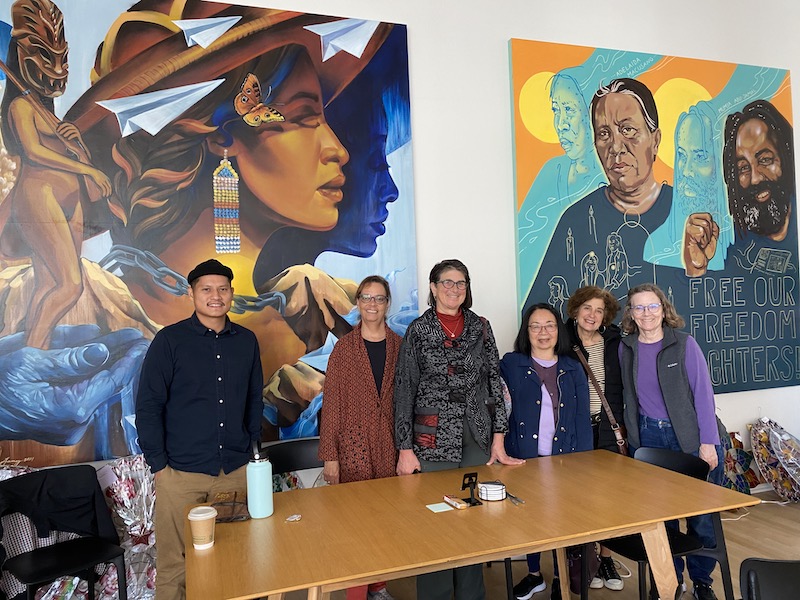
Linda Wing (third from right) organized a walking tour of the Filipino Cultural Heritage District guided by Mario de Mira (left.)
I have roots in San Francisco. My great-great-grandfather landed there in 1854 as a 12-year-old immigrant from China. His children and grandchildren were all born in Chinatown. When the 1906 earthquake devastated the city, the entire clan consisting of three generations took refuge in Oakland – and stayed there. Thereafter, as younger generations branched out across the nation, San Francisco became a place rarely visited, barely remembered as our family’s original ancestral home. I for one worked for 30 years in Boston, Chicago, and the Inland Empire before retiring to the East Bay. Looking for a way to become acquainted with San Francisco in a deeper way than occasional museum visits afford, I was attracted to an OLLI course about the history and culture of the city. I learned invaluable lessons in the classroom and beyond.
Lessons Learned in the Classroom
In the classroom, I learned how economic booms and busts as well as immigrants from all over the world have shaped San Francisco. The Gold Rush was San Francisco’s first economic boom; it caused the city’s population to explode from 400 in 1845 to 50,000 in 1860. The 1906 earthquake precipitated a bust that some economists describe as enduring for 50 years. Most recently, the city experienced a boom associated with “big tech” followed by the current bust, signified by vacant office buildings that emptied during the pandemic lockdown. Throughout San Francisco’s history, a large population of immigrants and their descendants has steadily comprised the city’s economic backbone – despite being scapegoated during recessions and displaced by urban renewal policies. Census estimates indicate that 34 percent of San Franciscans are foreign-born while 43 percent live in households where Chinese, Spanish, Tagalog, Russian, or another non-English language is spoken.
In recognition of the diverse cultures that have long energized the city, San Francisco decided in 2018 to support ten cultural heritage districts with city funds. The Filipino Cultural Heritage District in SoMa (South of Market Street) is one of the ten. The anchor organization is SOMA Pilipinas.
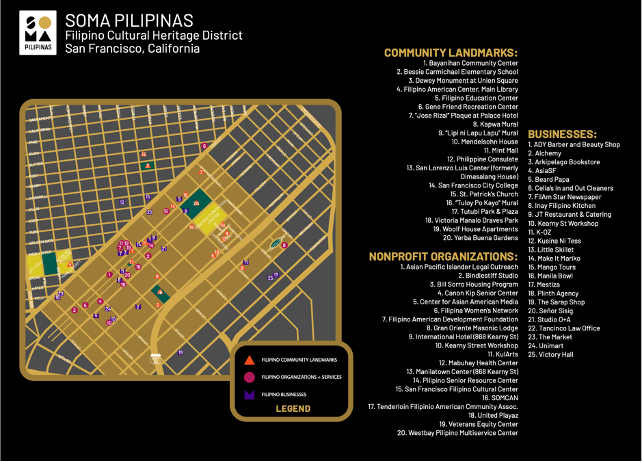
I learned that SOMA Pilipinas offers ethnotours of the Filipino Cultural Heritage District. I requested one and invited OLLI friends to join me. We were fortunate to be guided by Mario de Mira, a hip-hop artist with experience performing in many of the cultural heritage district venues who is also the organization’s operations manager.
Lessons Learned Beyond the Classroom
In SoMa, we learned that colonization and redevelopment have shaped the history of Filipino Americans. The first Filipinos came to North America in the 16th century. They were crew members on Spanish galleons from Manila. Spain had colonized the Philippines in the 16th century, Mexico too, and was looking for a harbor along the California coast where ships could stop to rest and regroup while en route between the two colonies. In the 1920s, large numbers of Filipinos began coming to California to fill labor shortages in canneries and agricultural fields. They were admitted as “nationals,” due to the US colonization of the Philippines from 1898 to 1946. Their entry port was San Francisco where they created a home base in the form of Manilatown – 10 blocks of small businesses and affordable housing located in the area marked by Kearny, Jackson, and Bush Streets. A half-century later, Manilatown had been eradicated by the city’s redevelopment policies, despite ten years of resistance and a “last stand” taken in 1977 by 3,000 people who protested the demolition of a residential hotel where elders lived. Manilatown’s demise led many residents to move to SoMa. Yet redevelopment continued to destabilize their lives, causing further displacement. Gentrification is now an added factor.
SOMA Pilipinas works to engender celebrations of history and culture as well as collective action toward a better and sustainable future. To do so, it embodies and evokes bayanihan — the joyful, selfless spirit of a community working in unity towards a common goal. As our guide led us on a walk through the cultural heritage district, we saw expressions of bayanihan everywhere.

We learned that SOMA Pilipinas orchestrated the creation and display of 300 street banners to foster pride during the severe hardship of the pandemic. During that time, elders feared anti-Asian attacks, residents were laid off from their jobs, small businesses closed, and nurses disproportionately lost their lives. We spotted several banners and admired their depiction of SoMa residents, artists, families, business owners, and community workers. Installed during Filipino American History Month, they build upon the legacy of past community resilience to renew determination to rise and recover yet again.
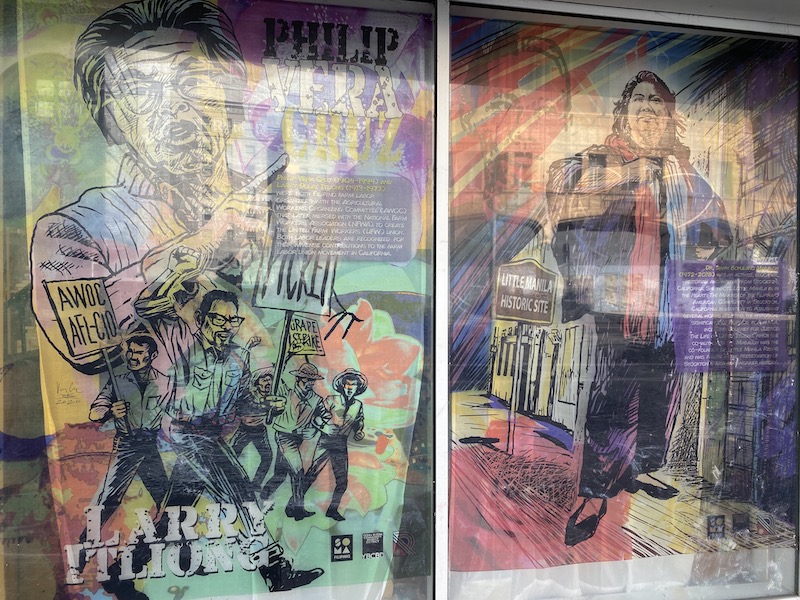
Our attention was captured by portraits that enliven the picture windows of Balay Kreative, a makerspace for artisans. We learned about the stories behind the portraits. Philip Veracruz and Larry Itliong (left) were farmworker organizers who persuaded Cesar Chavez and Dolores Huerta to form an alliance that led to the legendary United Farmworkers Strike in 1965. Dawn Malabon (right) was an activist-scholar who fought for the preservation of Little Manila in Stockton, documented and taught Filipino American history, and is respected as one of the founders of the field.
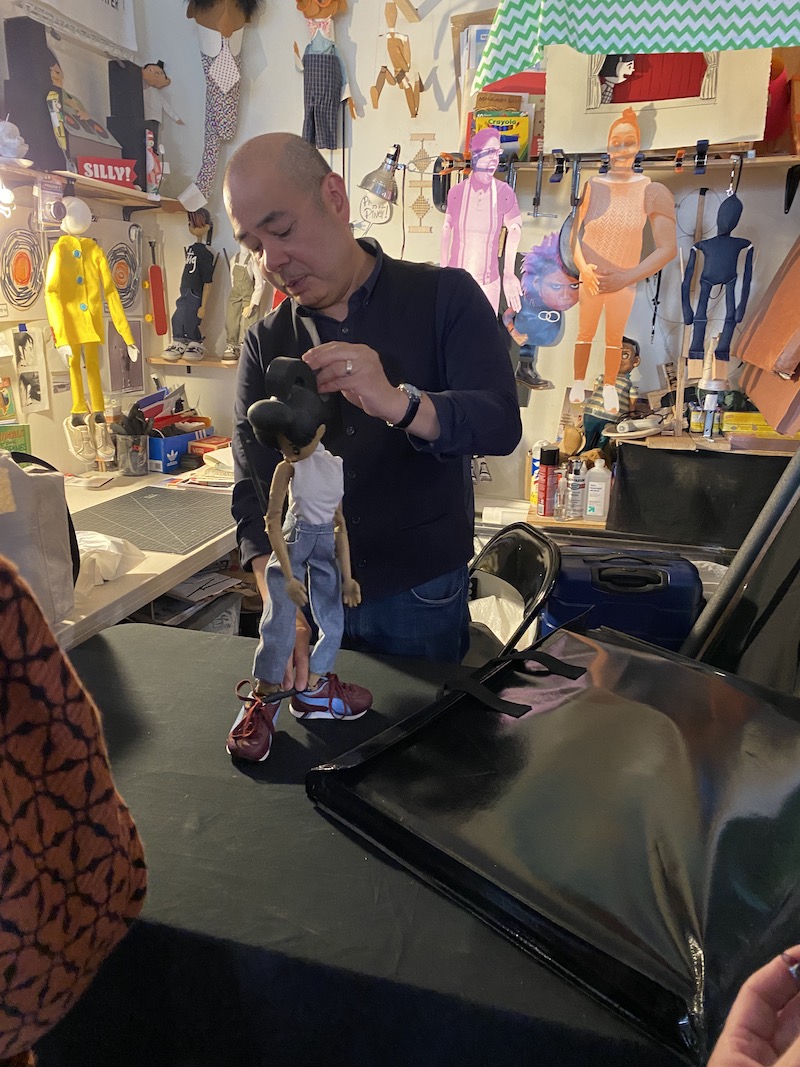
An artisan noticed us admiring the window portraits and invited us inside. We found ourselves surrounded by art – fabric art, paintings, sculptures, video productions. We met Ramon Abad, a master puppeteer. He graciously paused his preparations to perform for children at a local library to explain his craft to us. We learned about puppets that are animated in different ways – hand puppets, rod puppets, shadow play puppets, and marionettes – and were delighted by the puppets’ portrayal of characters that look like SoMa’s children and youth.

This is a bird’s eye view of a creatively designed park that we enjoyed exploring. Graffiti covering the walls of brick buildings along one side was left intact, while sculptures as tall as trees provide shelter from the sun. Opened in 2022, the park is the site of night markets and community events. We learned that it exists as the result of a developer’s agreement with the city to provide “community benefits” to the people of the Filipino Cultural Heritage District. In return, the city supports the developer’s plan to build mixed-income housing, including the high-rise, luxury apartment tower adjacent to the park.
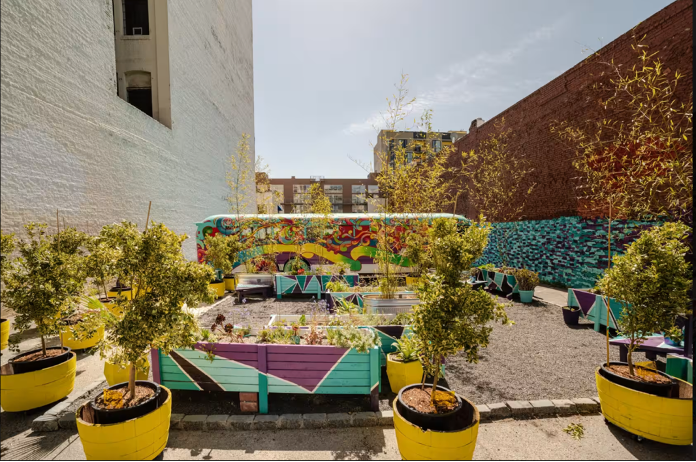
Our view into Kapwa Gardens was limited because it is closed to make way for new senior housing. Still, we could imagine what this photo depicts. We learned that Kapwa Gardens was a parking lot inventively transformed by Kultivate Labs into a safe, colorful outdoor respite for the health and healing of seniors during the pandemic. Post-pandemic, the gardens became a place for performances, fairs, classes, summer camps, and other community activities as well. Construction of 100 affordable apartments and studios for seniors with on-site senior services is scheduled to start in 2025.

We ate lunch at a picnic table in Victoria Manalo Draves Park. We learned that Draves won gold medals in the 1948 Olympics for springboard and platform diving. Born and raised in SoMa, Draves was the first woman to win two gold medals for diving in the same games and the first Asian American to win a gold medal. Not permitted to become a member of a San Francisco swimming and diving club, Draves was advised to drop her Filipino father’s surname of Manalo and use her English immigrant mother’s maiden name of Taylor to try to avoid further discrimination. In 2005, San Francisco renamed SoMa Park to acknowledge her courage and accomplishments.

Across the street from the park, we scanned the cityscape where SOMA Pilipinas envisions the installation of a bronze gateway to the cultural heritage district. We learned that the gateway’s design by artist Franceska Gamez was inspired by the concept of pagmamano — inheritance. From each end of the gateway, hands reach across the arch to give and receive the wisdom of elders.
Next to one end of the future gateway is Bindlestiff, a black box theater venue that has showcased Filipino American performance artists since 1997. Our guide, who has performed at Bindlestiff, indicated that we would refrain from crossing the street to see the theater up close. Why? It is a core value of SOMA Pilipinas to respect the privacy and dignity of unhoused people, some of whom were encamped in front of the Bindlestiff entrance.
We were reminded of Dorothea Lange’s photograph entitled Bindlestiff, taken during the Great Depression. The photograph captures a bindlestiff, a migrant, with his belongings in a bedroll slung over his shoulder walking alone across the Arizona desert to California, hoping to find work and housing. His privacy and dignity are intact; the shot is from the rear; we cannot see his face; but at the same time, he is seen. The first generation of Filipino Americans, nearly all young men, came to San Francisco for the same purpose, journeying not across a desert but a vast ocean instead. Perhaps this is the lasting lesson we learned from the classroom and a half-day in SoMa: to see and be seen – in hardship and joy, solitude and solidarity, childhood and elderhood, past and present – is humanity’s quintessential expression.
Linda Wing, Ph.D., is an OLLI @Berkeley member and volunteer who spent more than 45 years working to transform public schools in order to enable students in the nation’s cities to learn and achieve at high levels.